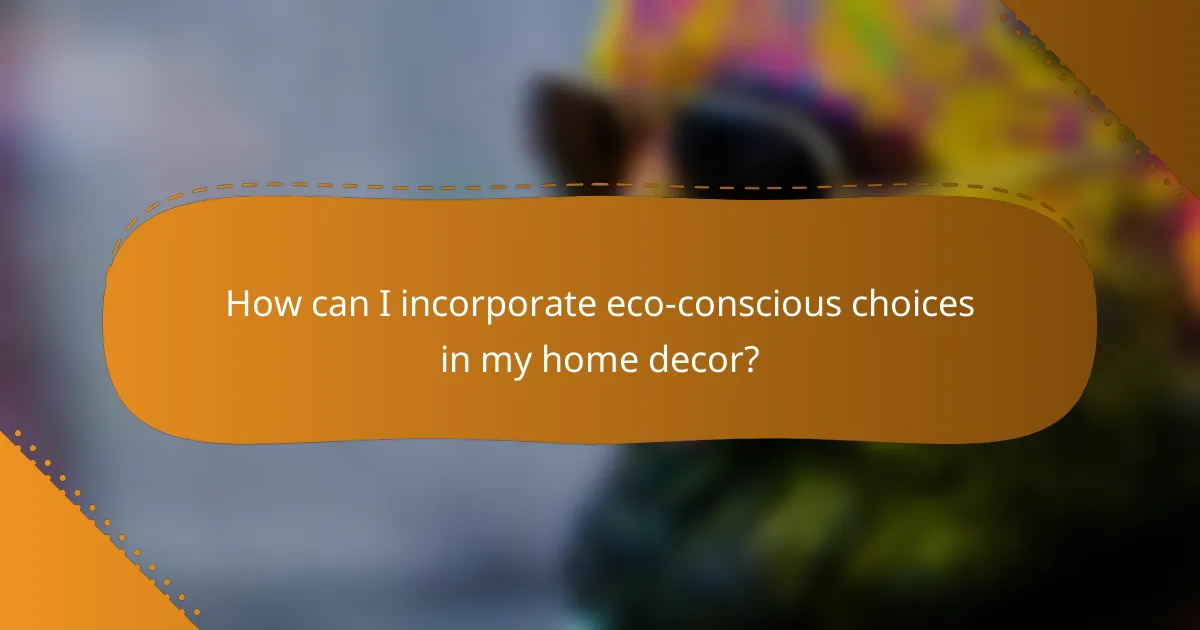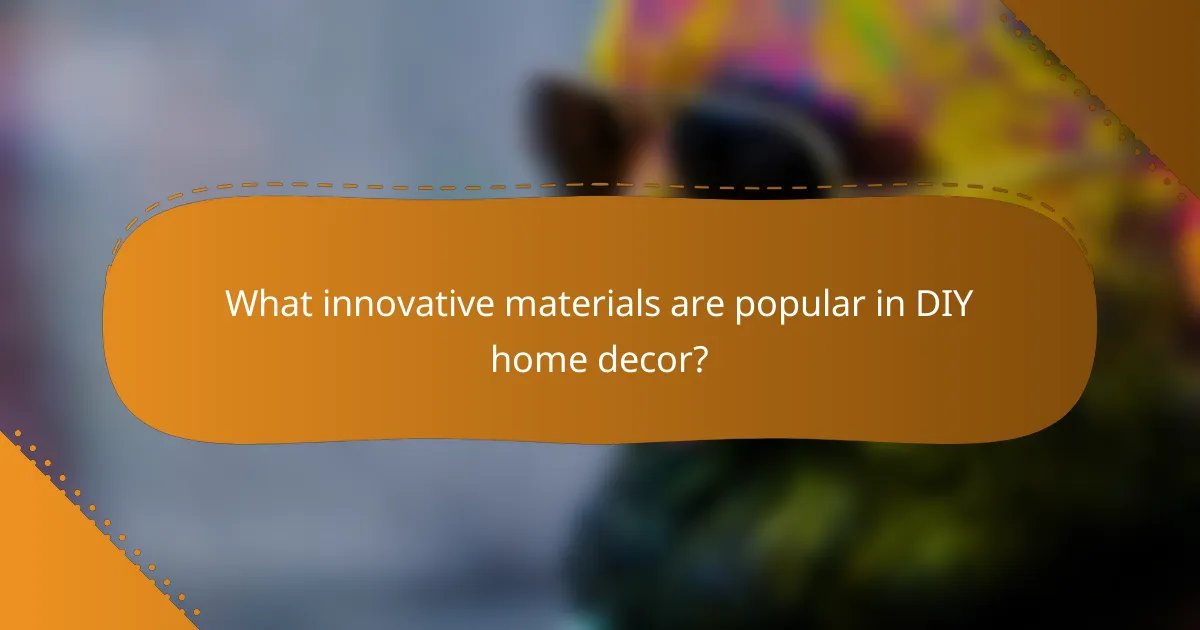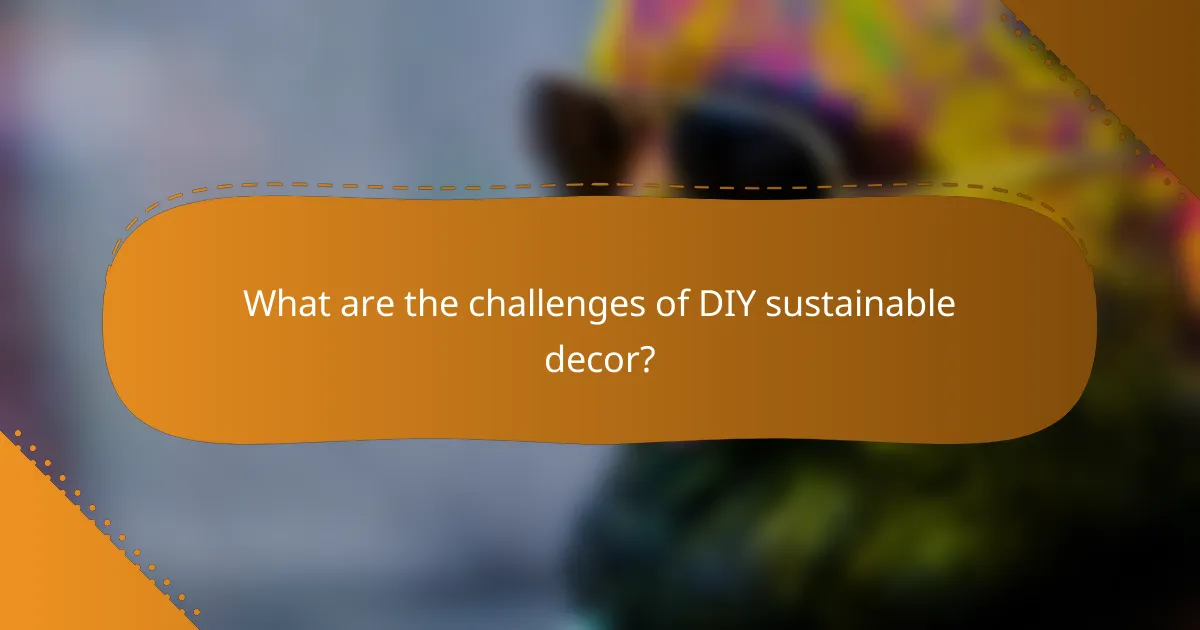In today’s DIY home decor landscape, sustainability is at the forefront, encouraging individuals to embrace eco-friendly practices that enhance both aesthetics and environmental health. By focusing on innovative materials like bamboo and recycled glass, as well as upcycling furniture and adopting minimalist designs, homeowners can create beautiful spaces that reflect their commitment to sustainability. Making conscious choices in materials and technologies not only reduces waste but also fosters a healthier living environment.

What are the top DIY home decor trends for sustainability?
The top DIY home decor trends for sustainability focus on eco-friendly practices that reduce waste and promote environmental health. Key trends include biophilic design, upcycled furniture, natural materials, minimalist aesthetics, and energy-efficient lighting.
Biophilic design elements
Biophilic design incorporates natural elements into home decor to enhance well-being and connect occupants with nature. This can include indoor plants, natural light, and organic shapes in furniture and decor. Consider using large potted plants or green walls to bring life into your space.
When implementing biophilic design, choose plants that thrive indoors and require minimal maintenance. Popular options include snake plants, pothos, and peace lilies, which also improve indoor air quality.
Upcycled furniture
Upcycled furniture involves repurposing old or discarded items into new, functional pieces, reducing waste and adding unique character to your home. This trend encourages creativity, allowing you to transform items like wooden pallets into coffee tables or old dressers into stylish storage solutions.
To successfully upcycle, assess the condition of the furniture and choose projects that match your skill level. Basic tools and materials, such as sandpaper, paint, and hardware, can help you achieve a polished look without significant investment.
Natural materials
Using natural materials in decor promotes sustainability by minimizing the use of synthetic products. Wood, stone, bamboo, and organic textiles are popular choices that add warmth and texture to spaces. Look for reclaimed wood or sustainably sourced materials to further enhance eco-friendliness.
When selecting natural materials, consider their durability and maintenance requirements. For instance, bamboo is a strong, renewable option for flooring, while cotton and linen are excellent choices for upholstery and curtains.
Minimalist aesthetics
Minimalist aesthetics focus on simplicity and functionality, promoting a clutter-free environment that reduces consumption. This trend encourages fewer, high-quality items that serve a purpose, leading to less waste and a more serene living space.
To embrace minimalism, declutter your home and keep only items that you truly need or love. Invest in versatile furniture that can serve multiple functions, such as a sofa bed or nesting tables, to maximize space and utility.
Energy-efficient lighting
Energy-efficient lighting is essential for sustainable home decor, reducing energy consumption and lowering utility bills. LED bulbs are a popular choice, using significantly less energy than traditional incandescent bulbs while lasting much longer.
When upgrading your lighting, consider installing dimmer switches or smart lighting systems that allow you to control brightness and energy use. Additionally, maximize natural light by using sheer curtains and strategically placing mirrors to reflect light throughout your space.

How can I incorporate eco-conscious choices in my home decor?
Incorporating eco-conscious choices in home decor involves selecting materials and practices that minimize environmental impact. Focus on sustainable resources, non-toxic products, and energy-efficient technologies to create a healthier living space.
Using non-toxic paints
Non-toxic paints are essential for a safe home environment, especially in spaces where children or pets spend time. Look for paints labeled as low-VOC (volatile organic compounds) or zero-VOC, which emit fewer harmful chemicals into the air. Brands like Benjamin Moore and Sherwin-Williams offer eco-friendly options that maintain quality and durability.
When painting, consider using natural pigments and organic materials. These alternatives not only reduce toxicity but also provide unique finishes. Always check for certifications like Green Seal or the EPA’s Safer Choice to ensure the paint meets environmental standards.
Choosing sustainable textiles
Sustainable textiles are made from organic, renewable, or recycled materials, reducing the carbon footprint of your home. Fabrics like organic cotton, linen, and hemp are excellent choices as they require fewer pesticides and water than conventional materials. Look for certifications such as GOTS (Global Organic Textile Standard) to verify sustainability claims.
Incorporate textiles into your decor through rugs, curtains, and upholstery. Consider second-hand options or upcycling old fabrics to create unique pieces. This not only saves money but also reduces waste, aligning with eco-conscious principles.
Implementing smart home technology
Smart home technology can significantly enhance energy efficiency, making it a smart choice for eco-conscious decor. Devices like smart thermostats, energy-efficient lighting, and automated blinds help reduce energy consumption by optimizing usage based on your habits. Brands like Nest and Philips Hue offer user-friendly solutions that can be integrated into any home.
When selecting smart devices, consider their energy ratings and compatibility with existing systems. Look for products that provide real-time energy usage data, allowing you to make informed decisions about your consumption. This not only benefits the environment but can also lead to cost savings on utility bills.

What innovative materials are popular in DIY home decor?
Innovative materials in DIY home decor focus on sustainability and eco-friendliness, offering unique aesthetics and functionality. Popular options include bamboo, recycled glass, and hemp-based materials, each providing distinct benefits for environmentally conscious projects.
Bamboo products
Bamboo is a fast-growing, renewable resource that is increasingly used in DIY home decor. Its natural strength and lightweight properties make it ideal for furniture, wall art, and decorative accents.
When choosing bamboo products, look for those that are certified by organizations like the Forest Stewardship Council (FSC) to ensure sustainable sourcing. Consider using bamboo for items such as shelving, picture frames, or even flooring to add a touch of nature to your space.
Recycled glass decor
Recycled glass decor is a versatile option that can add color and texture to any room. Items made from recycled glass, such as vases, lamps, and decorative tiles, help reduce waste while providing unique designs.
When selecting recycled glass pieces, check for local artisans or stores that specialize in eco-friendly products. This not only supports local economies but also ensures that you are purchasing high-quality, sustainable items.
Hemp-based materials
Hemp-based materials are gaining popularity in DIY home decor due to their durability and eco-friendliness. Hemp can be used in textiles, wall coverings, and even furniture, offering a sustainable alternative to conventional materials.
When incorporating hemp into your projects, consider using hemp fabric for upholstery or curtains, which are both stylish and environmentally responsible. Look for products that are certified organic to ensure they are free from harmful chemicals.

What are the benefits of sustainable home decor?
Sustainable home decor offers numerous benefits, including reduced environmental impact, improved indoor air quality, and long-term cost savings. By choosing eco-conscious materials and practices, homeowners can create beautiful spaces that are also kind to the planet.
Reduced environmental impact
Using sustainable materials in home decor significantly lowers the environmental footprint of your living space. Materials like reclaimed wood, bamboo, and recycled metals require less energy and resources to produce compared to conventional options.
Additionally, opting for local products minimizes transportation emissions, supporting local economies while reducing carbon footprints. Look for certifications like FSC (Forest Stewardship Council) to ensure responsible sourcing.
Improved indoor air quality
Sustainable home decor often involves using non-toxic paints, finishes, and materials that emit fewer volatile organic compounds (VOCs). This leads to better indoor air quality, which is crucial for health, especially for children and those with allergies.
Incorporating plants can further enhance air quality by filtering pollutants. Consider adding species like peace lilies or snake plants, which are known for their air-purifying properties.
Cost savings over time
Investing in sustainable home decor can lead to significant cost savings in the long run. Energy-efficient appliances and fixtures reduce utility bills, while durable materials often require less maintenance and replacement.
For instance, LED lighting and energy-efficient windows can lower energy costs by up to 30%. While the initial investment may be higher, the savings on energy and maintenance can make sustainable choices more economical over time.

How do I select eco-friendly decor items?
Selecting eco-friendly decor items involves choosing products that minimize environmental impact and promote sustainability. Focus on materials that are renewable, recycled, or sourced responsibly, and consider the overall lifecycle of the items you purchase.
Researching certifications
Look for certifications that indicate a product meets specific environmental standards. Common certifications include Forest Stewardship Council (FSC) for wood products, Global Organic Textile Standard (GOTS) for textiles, and Energy Star for energy-efficient appliances.
These certifications help ensure that the items are produced sustainably and ethically. Always verify the authenticity of the certification by checking the issuing body’s website or documentation.
Evaluating product lifecycle
Assess the product lifecycle by considering the materials used, the manufacturing process, and the end-of-life options. Items made from biodegradable or recyclable materials are preferable, as they reduce waste and environmental harm.
Additionally, consider the durability of the product. Investing in high-quality items that last longer can be more sustainable than frequently replacing cheaper alternatives. Look for products that offer repair options or take-back programs to further enhance sustainability.

What are the challenges of DIY sustainable decor?
DIY sustainable decor presents several challenges, including sourcing eco-friendly materials, ensuring durability, and managing costs. Balancing aesthetics with sustainability often requires creativity and research to find the right solutions.
Finding eco-friendly materials
One of the primary challenges in DIY sustainable decor is locating materials that are both environmentally friendly and aesthetically pleasing. Reclaimed wood, recycled metals, and organic fabrics are excellent choices, but they may not always be readily available. Consider local suppliers or online marketplaces that specialize in sustainable products.
When sourcing materials, verify their sustainability credentials. Look for certifications such as FSC (Forest Stewardship Council) for wood or GOTS (Global Organic Textile Standard) for textiles to ensure you are making eco-conscious choices.
Cost considerations
While DIY projects can save money, sustainable materials often come at a premium. Budgeting for eco-friendly options may require adjusting your overall project scope. It’s wise to compare prices across different suppliers and consider using a mix of new and reclaimed materials to balance costs.
Keep in mind that investing in quality sustainable materials can lead to long-term savings. Durable products reduce the need for replacements, ultimately saving money and resources over time.
Skill level and time investment
Another challenge is the skill level required for certain DIY projects. Some sustainable decor items may involve advanced techniques or tools that can be intimidating for beginners. Start with simpler projects to build confidence and gradually tackle more complex designs.
Time investment is also a factor. Sustainable decor projects often require more planning and preparation, from sourcing materials to executing the design. Setting realistic timelines and breaking projects into manageable steps can help keep you on track.


